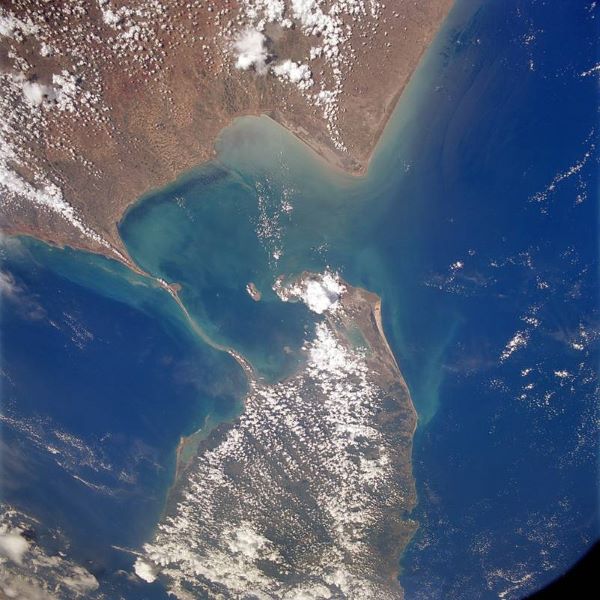Could This Be The Legendary “Magic Bridge” Connecting India And Sri Lanka? – by Patrick Ranasinghe
 Location The bridge starts as a chain of shoals from the Dhanushkodi tip of India’s Pamban Island. It ends at Sri Lanka’s Mannar Island. Pamban Island is accessed from the Indian mainland by the 2-km-long Pamban Bridge. Mannar Island is connected to mainland Sri Lanka by a causeway.
Location The bridge starts as a chain of shoals from the Dhanushkodi tip of India’s Pamban Island. It ends at Sri Lanka’s Mannar Island. Pamban Island is accessed from the Indian mainland by the 2-km-long Pamban Bridge. Mannar Island is connected to mainland Sri Lanka by a causeway.
Geological evolution Considerable diversity of opinion and confusion exists about the nature and origin of this structure. In the 19th century, two significant theories were prominent in explaining the structure. One considered it to be formed by the process of accretion and rising of the land. At the same time the other surmised that it was established by the breaking away of Sri Lanka from the Indian mainland. The friable calcareous ridges later broke into large rectangular blocks, which perhaps gave rise to the belief that the causeway is an artificial construction.
According to V. Ram Mohan of the Centre of Natural Hazards and Disaster Studies of the University of Madras, “reconstruction of the geological evolution of the island chain is a challenging task and has to be carried out based on circumstantial evidence”. The lack of comprehensive field studies explains many of the uncertainties regarding the nature and origin of Adam’s Bridge. It mostly consists of a series of parallel ledges of sandstone and conglomerates that are hard at the surface and grow coarse and soft as they descend to sandy banks.
Studies have variously described the structure as a chain of shoals, coral reefs, a ridge formed in the region owing to thinning of the earth’s crust, a double tombolo, a sand spit, or barrier islands. One account mentions that this landform was formerly the world’s largest tombolo. The tombolo split into a chain of shoals by a slight rise in mean sea level a few thousand years ago. The tombolo model affirms a constant sediment source and a high uni-directional or bi-directional (monsoonal) longshore current

The Marine and Water Resources Group of the Space Applications Centre (SAC) of the Indian Space Research Organisation (ISRO) concludes that Adam’s Bridge comprises 103 small patch reefs.[16] The SAC study, based on satellite remote sensing data but without actual field verification, finds the reefs lying in a linear pattern. The feature consists of the reef crest (flattened, emergent, especially during low tides, or nearly emergent segment of a reef), sand cays (accumulations of loose coral sands and beach rock) and intermittent deep channels. Other studies variously designate the coral reefs as ribbon and atoll reefs.
The geological process that gave rise to this structure has been attributed in one study to crustal down warping, block faulting, and mantle plume activity.[20] In contrast, another theory attributes it to continuous sand deposition and the natural process of sedimentation leading to the formation of a chain of barrier islands related to rising sea levels. Another theory affirms the origin and linearity of the bridge to the old shoreline (implying that the two landmasses of India and Sri Lanka were once connected) from which shoreline coral reefs developed.
Another study attributes the origin of the structure to longshore drifting currents which moved in an anticlockwise direction in the north and clockwise direction in the south of Rameswaram and Talaimannar. The sand could have been dumped in a linear pattern along the current shadow zone between Dhanushkodi and Talaimannar with the later accumulation of corals over these linear sand bodies. In a diametrically opposing view, another group of geologists propose a crustal thinning theory, block faulting and a ridge formed in the region owing to thinning and asserts that development of this ridge augmented the coral growth in the area and in turn coral cover acted as a ‘sand trapper’.
One study tentatively concludes that there is insufficient evidence to indicate eustatic emergence and that the raised reef in southern India probably results from a local uplift. Other studies also conclude that during periods of lowered sea level over the last 100,000 years, Adam’s Bridge has provided an intermittent land connection between India and Sri Lanka. According to famous ornithologists Sidney Dillon Ripley and Bruce Beehler, this supports the vicariance model for speciation in some birds of the Indian Subcontinen
Patrick Ranasinghe







